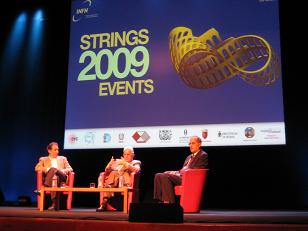
By Edwin Cartlidge in Rome
Whether string theory can tell us anything about reality is a moot point. In the last two or three years this purported “theory of everything” – in principle unifying gravity with the three other forces in nature – has been given a kicking by certain scientists who see it as a kind of intellectual play thing that makes no testable predictions. See What Gina says.. for a taste of that debate.
Certainly the names of some of the talks at the world’s leading string-theory conference, Strings 2009, held in Rome this past week, were on the abstract side. “Holography and the S-Matrix”, “Superconducting black holes”, and “Stringy instantons and duality” give some flavour of the discussions held among the roughly 500 participants at the five-day conference. The fact that the meeting was held at the Pontifical University of Saint Thomas Aquinas only seemed to reinforce its other-worldliness.
But help was on hand for outsiders wanting to try and understand what on Earth this all means. Earlier today, particle physicist grandee Nicola Cabibbo introduced the curious of Rome to two of the big names of string theory – Edward Witten and Brian Greene. Witten, widely regarded as the leading figure in string theory, introduced himself with a few words of Italian and then told the audience what physicists hope to discover when they finally, hopefully, switch on the Large Hadron Collider at the CERN laboratory in Geneva this autumn.
In addition to the expected Higgs boson, the endower of all mass, Witten said that within the debris of particle collisions at the LHC might also be evidence of dark matter and of supersymmetry, which says that a whole slew of new fundamental particles must exist for there to be balance in the subatomic world. And one of the intriguing things about supersymmetry is that it could provide some kind of evidence for string theory.
It was at this point that Witten handed the baton to Greene. Greene is well known for his popularization of science, and with good reason. With some snazzy graphics and his flair for performing, he told us why it is so hard to come up with a theory of quantum gravity, explaining that the smooth variation of space-time as described by general relativity “runs headlong” into the turbulent, chaotic world of quantum mechanics. Postulating that the ultimate constituents of matter are tiny lengths of string, whose different modes of vibration correspond to different fundamental particles, is one way of resolving this problem, he went on, because such strings are like spread-out points that smooth the wild undulations at the smallest scale.
This model, however, has some very odd implications. Greene pointed out that string theory requires an extra 6 (or 7) dimensions of space in addition to the three that we are aware of. Helpfully, these dimensions are so small that we can’t see them, but unhelpfully there are rather a lot of ways of curling these extra dimensions up – some 10500 different ways as it turns out. And we would have to study all 10500 if we want to find out whether or not string theory describes the real world.
For Greene, all is not lost, however. He pointed out that 10500 is somewhat bigger than 10120, and that’s a measure of how much we don’t understand dark energy. In a nutshell he argued that if we happen to live in one of the few of the 10500 universes where conditions are just right for us to exist then there’s a damn good chance that we could have such an apparently statistically unlikely dark energy. For Greene, this suggests we might be on the right lines with string theory. Others may be less convinced.



